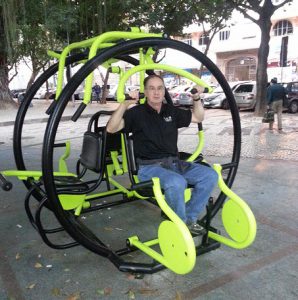The Physical Activity Guidelines Advisory Committee is composed of 17 nationally recognized experts in the fields of physical activity and health. These distinguished individuals agreed to serve on the Committee in a voluntary capacity to review current evidence and make recommendations that will help inform the next edition of the Physical Activity Guidelines for Americans. This post is part of a series of interviews with the Committee members to learn more about the men and women providing independent expertise and service to improve the health of the Nation.
Today, we are highlighting Dr. Russ Pate, Professor in the Department of Exercise Science in the Arnold School of Public Health at the University of South Carolina. On the Committee, Dr. Pate serves as chair of the Youth Subcommittee and is a member of the Cardiometabolic Health and Weight Management Subcommittee.
What led to your interest in physical activity?
I always knew I wanted to do something related to physical activity when I was growing up. My dad was a coach and P.E. teacher, and I wanted to follow in his footsteps. When I got to college, I decided to pursue graduate education in exercise physiology, and I have continued to work in that field ever since.

Tell me about some of your recent research.
I study physical activity patterns in children and youth from early childhood through adolescence. I recently completed an NIH-funded study that developed and tested a preschool physical activity intervention known as SHAPES (Supporting Health and Activity in Preschool Environments). My research team then developed an online program to prepare preschool teachers to deliver SHAPES, and currently we are using it to train preschool teachers across South Carolina to help young children become more active by incorporating physical activity into their classrooms.
I’m also interested in understanding the decline in physical activity that occurs as children transition from elementary school to middle school and high school. I am currently conducting a prospective cohort study that is following youth from 5th through 11th grade. This study seeks to identify the factors (e.g., parents, community, school, etc.) that contribute to changes in physical activity during this period and to understand how and why they affect physical activity levels.
Why were you interested in participating in the Physical Activity Guidelines Advisory Committee?
I think that the Physical Activity Guidelines for Americans are one of the most important accomplishments of the physical activity and public health fields to date. By developing and now updating the Guidelines, HHS is recognizing the important relationship between physical activity and health. Issuing evidence-based Guidelines won’t solve the issue of physical inactivity, but it is a good step towards a solution. When I was nominated to serve on the Committee, I felt a responsibility to contribute.
Explain your view of the role of physical activity in health.
Despite the fact that our bodies are designed to move, our society prioritizes ease and convenience, which make it all too easy to lead a sedentary lifestyle. Increasing physical activity at the population level is not an easy undertaking. The impact of physical activity on public health is enormous. Over 50 years of research show that higher physical activity levels reduce risk for developing non-communicable diseases. I believe physical activity has a tremendous capacity to improve health, second only to tobacco cessation.
What tips would you give Americans who are trying to be more physically active?
I believe there is a form of physical activity for everybody — we just have to help them find it. If people can find a form of physical activity that they can access and enjoy, the odds of developing an active lifestyle are excellent. Different people have different motivations for being physically active. Some people have an innate drive to be physically active; for others, setting goals helps. Regardless of what motivates a person, finding a short-term benefit usually helps. If people are active today and find it rewarding, they are more likely to do it again tomorrow.
~
The Office of Disease Prevention and Health Promotion would like to personally thank each of the members for their dedication and service on the Committee. The Committee’s independent review of the scientific literature is the result of thousands of hours of work and will culminate with the submission of the 2018 Physical Activity Guidelines Advisory Committee Scientific Report to the Secretary of the Department of Health and Human Services (HHS). HHS will use the report to develop the next edition of the Physical Activity Guidelines for Americans.